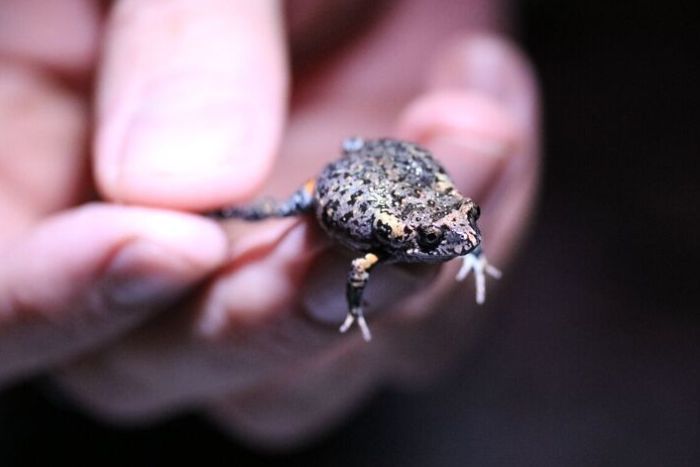Extremely rare 'flasher' frog discovered near Newcastle
Updated
A rare species of frog that flashes its bright orange groin in an effort to ward off predators has been discovered in swampland north of Newcastle.
Mahony's Toadlet is barely bigger than a human fingertip and was identified just kilometres from Newcastle Airport in the well-developed area of Port Stephens in New South Wales.
The tiny amphibian was immediately recognisable as a new species because of its unique marbled underbelly and bright orange groin.
The University of Newcastle's Simon Clulow discovered the frog several years ago, but said he stumbled across it by accident.
"I was actually just working in the field doing some unrelated studies on frogs that happen to be around the sand beds around Port Stephens and I heard a frog," Dr Clulow said.
"It sounded like a few other frogs we get out that way … but when I pulled this one up, straight away I knew it was something unique."
Discovered at Oyster Cove in Port Stephens, the frog has also been identified in swamps in the Myall Lakes and on the Central Coast of New South Wales.
Dr Clulow said Mahony's Toadlet had a unique way of keeping predators at bay, by flashing its bright-coloured groin when in danger.
 Photo:
A new species of frog, dubbed Mahony's Toadlet, has been discovered near Newcastle. (Supplied: Sheena Martin)
Photo:
A new species of frog, dubbed Mahony's Toadlet, has been discovered near Newcastle. (Supplied: Sheena Martin)
He said it was an unusual find so close to a large city.
"Species discovery still happen but these days it's usually in remote areas or of species that are hard to distinguish morphologically and so they need genetic tools to do so," he said.
"It's very unusual to find a species that is so morphologically distinct, especially near such a large city."
'Secretive' frog under threat by developers
 Photo:
Simon Clulow discovered the new frog species and says the find is extremely rare. (Supplied: Sheena Martin)
Photo:
Simon Clulow discovered the new frog species and says the find is extremely rare. (Supplied: Sheena Martin)
Dr Clulow said the frog had likely remained hidden for so long because it could camouflage in the wild.
The toadlet is native to Australia and has glands on its back similar to toads found in Europe and the Americas.
It was named after well-known frog expert and conservationist, Professor Michael Mahony.
But concerns are already being raised about the toadlet's future, with its natural habitat dominated by encroaching developments in popular coastal areas.
"It only occurs in these coastal sand beds and it's very patchy in distribution," Dr Clulow said.
"So it's actually under threat from sand mining, coastal developments and lots of other things, so we think it could be a threatened species."
The area where the frog was discovered is also part of a so-called red zone impacted by contamination from the Williamtown Air Force Base.
The contamination prompted a class action by residents against the Department of Defence who claim their health was at risk by toxic chemicals leaching into ground and surface water.
A report detailing the discovery of the toadlet has been published in the international scientific journal Zootaxa today.
Topics: animal-science, biology, human-interest, science-and-technology, oyster-bay-2225, williamtown-2318, newcastle-2300, gosford-2250
First posted








